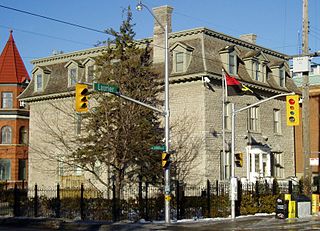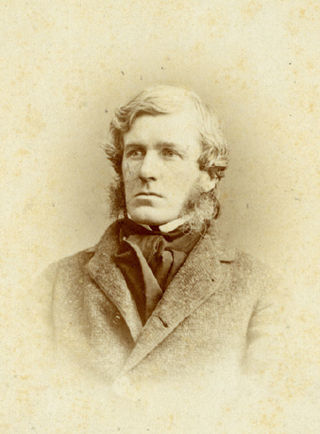
Vimy House was a warehouse in the Centretown West neighbourhood of Ottawa, Ontario, Canada that was used to store the collections of the Canadian War Museum from 1983 to 2004. The building, originally known as Champagne Garage was built to house the streetcars of the Ottawa Electric Railway. After the railway's closure in 1959, the Ottawa Transportation Commission used the warehouse for storing their buses up until 1979. The building was later acquired by the Canadian War Museum to be used as a storage facility for its collections when its Sussex Drive facility ran out of space. The building, later renamed Vimy House, became filled with a vast array of aged military paraphernalia including the world's largest collection of Canadian war art. While items from the Vimy House collection would occasionally be put on display at the museum itself, the public could also visit Vimy House on special open house days and tour its collection. The last open house was held on September 6, 2003.

Gloucester is a former municipality and now geographic area of Ottawa, Ontario, Canada. Located east of Ottawa's inner core, it was an independent city until amalgamated with the Regional Municipality of Ottawa–Carleton in 2001 to become the new city of Ottawa. The population of Gloucester is about 150,012 people.
Bytown is the former name of Ottawa, Ontario, Canada. It was founded on September 26, 1826, incorporated as a town on January 1, 1850, and superseded by the incorporation of the City of Ottawa on January 1, 1855. The founding was marked by a sod turning, and a letter from Governor General Dalhousie which authorized Lieutenant Colonel John By to divide up the town into lots. Bytown came about as a result of the construction of the Rideau Canal and grew largely due to the Ottawa River timber trade. Bytown's first mayor was John Scott, elected in 1847.

The Embassy of the Republic of Croatia is located in Toller House at the corner of Chapel and Daly Streets in the Sandy Hill neighbourhood of Ottawa, Ontario, Canada.

The Embassy of the Republic of Angola in Canada was the embassy of Angola in Canada. It was located in Panet House at the corner of Laurier Avenue and King Edward Avenue, next to the University of Ottawa. The embassy was closed in November 2018.

Billings Bridge is a bridge over the Rideau River in Ottawa. Bank Street passes over the river by way of this bridge. The bridge was named after Braddish Billings, who settled in this area and established a farm nearby in 1812. The first bridge, originally called Farmers Bridge, was built over the river here in 1830. The current bridge was built in 1916.
Braddish Billings was an early settler in the Ottawa area, for whom the community of Billings Bridge was named.
Horaceville is a historic site located on the Ottawa River in eastern Ontario, Canada. The site remained the property of the heirs of Hamnett Kirkes Pinhey until the 1970s, when the property was sold to the township. Today, The 88-acre (360,000 m2) heritage site is owned and operated by the City of Ottawa and Pinhey's home serves as a museum. The museum is open May 14 through August 31, Wednesdays to Sundays, 11 am to 5 pm. This location is also known as Pinhey's Point Historic Site. The property was designated by the City of Ottawa under Part IV of the Ontario Heritage Act as having cultural heritage value or interest. A bronze plaque erected on the site by the Ontario Heritage Foundation describes the property's history: "Hamnet Kirkes Pinhey 1784 - 1857 - A merchant and ship owner in his native England, Pinhey came to Upper Canada in 1820. For his services as King's messenger during the Napoleonic Wars, he received a 1000 acres land grant on the Ottawa River. Within a decade he had built up an estate which he named Horaceville after his elder son. In addition to a manor house and barns, it included mills, a store and church. Pinhey took a leading part in township and district affairs. He was appointed to the Legislative Council in 1847, served as Warden of the Dalhousie District, and as the first Warden of Carleton County. Horaceville remained in family hands until 1959 when it was purchased by the National Capital Commission."

Christ Church Cathedral is the Anglican cathedral in Ottawa, Ontario, Canada. The church is located at 414 Sparks Street in the northwest section of the city's downtown at the western end of Sparks Street on top of a promontory looking down to the Ottawa River.

The Bytown Museum is a museum in Ottawa located in the Colonel By Valley at the Ottawa Locks of the Rideau Canal at the Ottawa River, just below Parliament Hill. Housed in the Commissariat Building, Ottawa's oldest remaining stone building, the museum provides a comprehensive overview of the origins of Bytown and its development and growth into the present city of Ottawa.

Elkanah Billings is often referred to as Canada's first paleontologist. Billings was born on a farm by the Rideau River outside Bytown (Ottawa), now known as Billings Estate. His parents were named Lamira Dow and Braddish Billings. His family included an older sister named Sabra and an older brother Maj Braddish Billings Jr, who practised as an architect and served in the North-West Rebellion. His younger siblings were Samuel, Sarah and Charles. He was originally educated in law and in 1845, he was called to the Canadian bar. In 1856, he founded the journal the Canadian Naturalist . He continued to practise law until 1857, when he was hired to be the first paleontologist for Geological Survey of Canada (GSC). In his lifetime, he identified 1065 new species and 61 new genera, including Aspidella, the first documented fossil of the Ediacaran biota.
This is a timeline of the history of Ottawa.
The Nepean Museum is a museum in Ottawa, Ontario, Canada. It is a community-focused museum that preserves, makes accessible and communicates the former municipality of Nepean's history. Artifacts related to Nepean, from its beginnings to the 20th century, are restored and displayed in the museum galleries and grounds. The museum has an open concept exhibit area of approximately 2000sq ft. The museum collects, preserves, researches, exhibits and interprets the works of man and nature in Nepean. Its address is 16 Rowley Avenue, Ottawa, Ontario, Canada.

The Wolfville Historical Society is a registered charity that owns and maintains the Randall House Museum in Wolfville, Nova Scotia. This building dates from c.1812 and is operated as a seasonal museum, open to the public from June to September. The society collects, conserves, exhibits and stores artifacts and documents from the local area, and interprets the house, rooms, contents and the garden. Archives of documents and photographs are available to the public. The Society also supports the publication of books written about Wolfville's history.
The history of Ottawa, capital of Canada, was shaped by events such as the construction of the Rideau Canal, the lumber industry, the choice of Ottawa as the location of Canada's capital, as well as American and European influences and interactions. By 1914, Ottawa's population had surpassed 100,000 and today it is the capital of a G7 country whose metropolitan population exceeds one million.
The Wheelhouse Maritime Museum (WMM) was a maritime museum in Ottawa, Ontario, Canada. It opened officially on Monday, February 1, 1965, by the Underwater Society of Ottawa.. The Wheelhouse Maritime Museum was open to the public on Sunday afternoons from 1 to 5 p.m., and on Tuesdays and Thursdays evenings between 7 and 9 p.m. From February 1, 1965, until it closed in 1976, the museum was housed in the top-storey of 218 Cumberland Street in Ottawa.

The Kilmorie house is a heritage home located at 21 Withrow Avenue in Ottawa, Ontario, the former home of one of the region's earliest settlers. The house was built circa 1840-1850 for farmer William Scott, who emigrated to Upper Canada in 1819 from Ireland.












